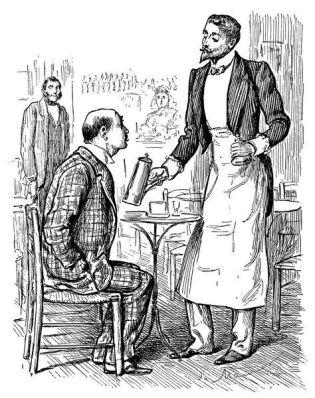
This is the last in this series of posts from one week in 1884 and I’m going to finish it with a summary of the reports that appeared in the Morning Post under the heading ‘Police Intelligence’ which again show the diversity of business the police magistrate courts of the Victorian capital dealt with.
The most serious case was at Clerkenwell where Mr Hosack fully committed Sidney Clay to trial at the Central Criminal Court (at Old Bailey). Clay, a 30 year-old tobacconist from Holloway Road, was accused of ‘having encouraged and endeavoured to persuade Eustace de Gruther, doctor of medicine, to kill and murder’ a baby boy who was just two months old.
Clay’s lawyer argued that the doctor, as the only witness, was trying to implicate his client but the magistrate decided that the case needed to be heard by a jury and bailed Clay for £200. In late February Clay was tried and convicted at the Bailey but it was recognized that the whole thing might not have been as intentional as it seemed at first. The jury recommended Clay to mercy and the judge gave him just six months hard labour. Interestingly here his age was given as just 21, not 30, so perhaps the reporter got it wrong at the original hearing – a reminder that we should always treat historical sources carefully.
Another tragedy of life was played out in Southwark Police court where Elizabeth Brockett was prosecuted for trying to kill herself. The 31 year-old (if we are to believe the report at least) was seen on London Bridge by a wharf labourer. John Flanaghan was alerted by a woman’s scream and looked up to see Elizabeth who had just discarded her bonnet and shawl and was about to launch herself into the Thames. He rushed to save her, and, with the help of a policeman, managed to drag her back from the brink.
In court the woman told Mr Slade that she was ‘in great distress of mind, owing to the loss of two children’. She’d been very ill but promised never to try to do anything like this again. She was released back into the care of her husband.
At Hampstead John Redworth didn’t appear when his case was called. He’d been summoned by an officer of School Board for neglecting to send his daughter, Justina (9) to school. This was a common enough sort of hearing but was very rarely reported so what made this one special? Well it was that perennial issue around travelling people. Redworth was a member of a community of ‘gipsies’ who had been camping on Hampstead Heath. Apparently Redworth’s was the only family that had children of school age and so his was the only summons made.
He turned up in the end but too late for the magistrate (Mr Andrews) who had already adjourned the case for a month. The encampment had moved on the magistrate was told, so perhaps the court would decide to leave the girl’s education for someone else to deal with.
At Marylebone William Bliss (a footman) was charged with theft and receiving a china vase. He appeared in the dock with his accomplice and fellow servant Catherine Churchyard. The pair worked for a family in Chelsea and claimed the case had just been broken and they’d hidden the evidence to save Catherine getting into trouble. Mr De Rutzen didn’t buy this version of events and remanded them for a week to see what the police could find out about the case. I fear that at best the couple would have been dismissed from service, at worst they might have to spend some time behind bars.
So in just four reports that day we have a child murder, an attempted suicide, servant theft, and a case of truancy involving travellers. If we added a fraud, a case of domestic violence, and some drunk and disorderly behaviour on the streets in the West End we would have a very normal day at the Police courts of Victorian London.
[from The Morning Post, Thursday, 31 January, 1884]








